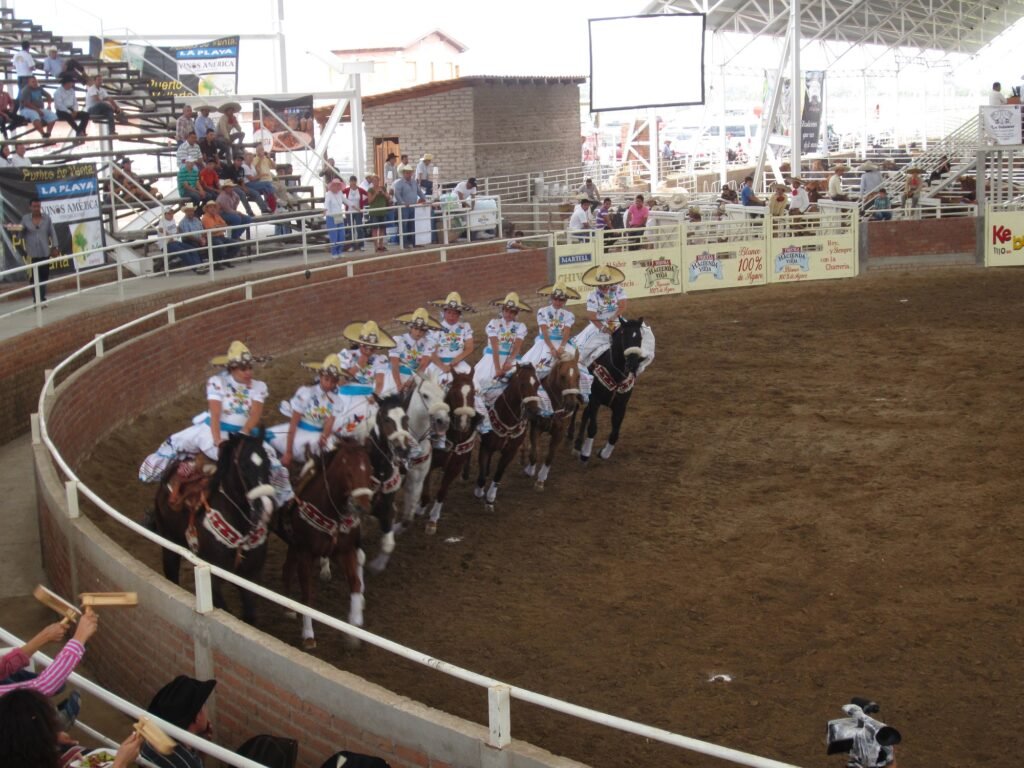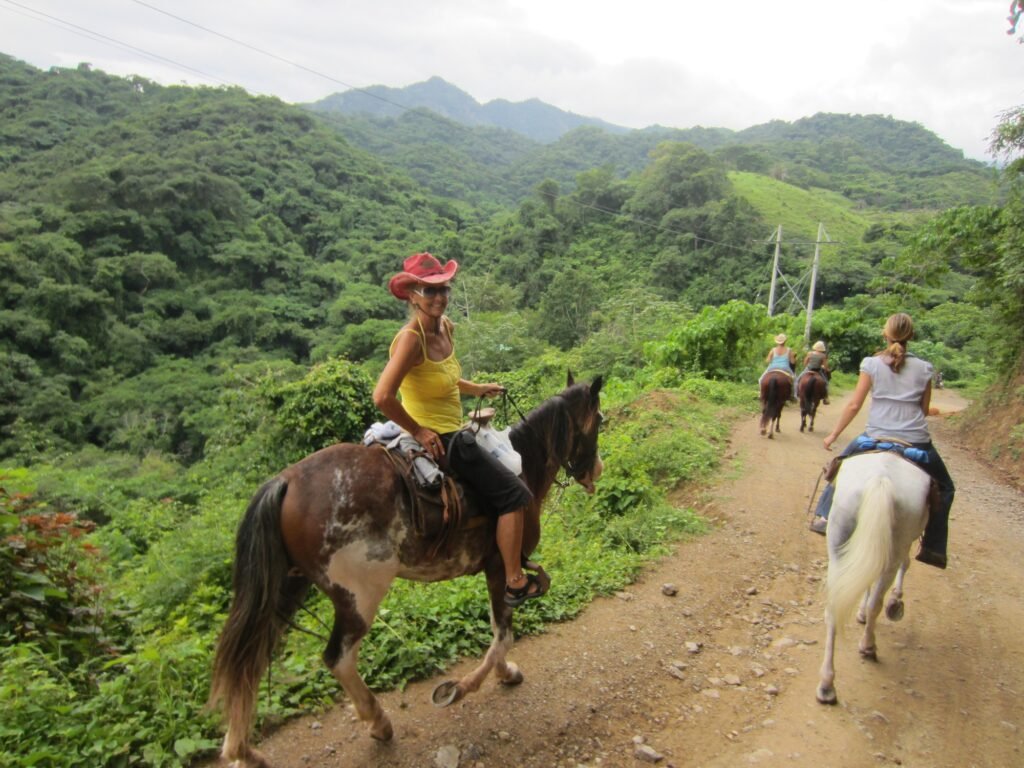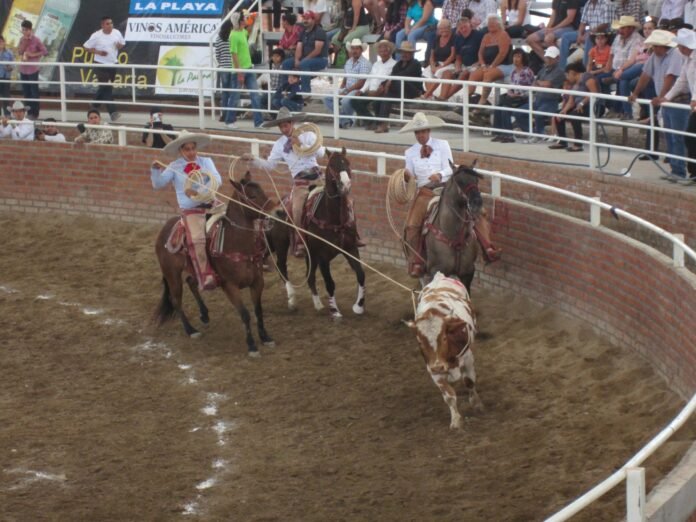With the International Charro Championships coming to the Arena Vallarta from January 31 – February 4, I thought I would share some information about the origins of this competition and the people who are an integral part of it.
Horses are an important part of the Mexican culture. Introduced by the Spanish in the 16th century, the horse plays a vital role in Mexico’s rural workforce and is a source of much pride and camaraderie.
Vaqueros was the name given to the Mexican cowboy in the 18th century. They usually lived on cattle ranches or ‘rancheros’ in rural areas and did all their horseback work. They were responsible for field chores, especially the care and maintenance of horses, livestock, and cattle. Some were also nomads who rode the county looking for jobs.
Charro is the Mexican cowboy in traditional charro dress patterned after the mariachi costume. Charros started in Jalisco and date back to the 17th century.
Today’s charros are the descendants of indigenous cowboys who were first enslaved and then employed by Spanish settlers to manage their newly acquired haciendas.

Escaramuzas originated as young women dressed in beautiful costumes riding sidesaddle and performing intricate maneuvers as entertainment for the wealthy hacienda landowners around Jalisco.
They organized themselves in 1953 and entered the local charrerias or rodeo competitions. Today, these choreographed synchronized exercises or skirmishes require courage, extensive knowledge of horses, the ability to direct them, and a lot of coordination.
Charra Escaramuza was awarded the Heritage of Humanity by UNESCO in 2018.
Charrería is a national sport and discipline arising from equestrian activities and livestock traditions used in the haciendas of old Mexico. The states of Jalisco and Hidalgo are considered the home of the charrería.
The horse breeds most commonly used are the Criollo and the Quarter Horse. UNESCO declared The Mexican Charrería an Intangible Heritage of Humanity in 2016.
There are nine categories for the charros to exhibit their skills with horse, bull, and rope.
Each team is awarded points for their performance, and winners compete on the final day for top recognition.

If you want your own experience on a horse in Jalisco, you can take a day or overnight ride up the surrounding mountains. Although this is far from a charrería, it does give you a unique experience, especially if you do an overnight. Here is mine!
Juan Gomez has been a cowboy forever. In fact, I think he was born riding a horse! He led us on my first cabalgata, Mexico’s answer to the trail ride, except these may last several days. Although I have been on many short rides with Juan, this was my first long ride. By short rides, I mean 2 to 3 hours, no galloping, with lunch and a couple cervezas after.
This ride was 8 hours through beautiful backcountry with an overnight at a small ranch. You have no idea how long 8 hours on a horse is until you try it. I could not put my knees together when I finally climbed off!
Juan brought several horses for us as we prepared to leave. The first couple of hours were awe-inspiring as we rode along dirt roads through the jungled mountains of the Sierra Madre. The vistas were breathtaking, the company enjoyable, and Juan, with his knowledge of the local plants and animals, was most educational.
We stopped for lunch in a very small pueblito where the local women had lunch prepared, and the men were cooking a huge caldron of chicharrones in pig fat for us to sample, washed down with a cold cerveza!
After arriving in the small town of Llanitos, we enjoyed dinner cooked in an outdoor kitchen on a wood stove. It was a delicious mixture of local fare, including blue tortillas, beans, corn, radishes, and, of course, more cervezas.
Talk around the campfire lulled me to sleep as I wandered to my bunkhouse bed for the night.
Morning dawned early with the sun rising over the mountains and the mists still hanging in the valley. After a quick trip to the rustic outhouse, we were ready for the hearty breakfast set before us.
Local tradition included chocomil, a concoction of warm milk straight from the cow mixed with chocolate syrup, and, if you dared, a shot or two of tequila. What a way to start the day!
It was time to head back to Vallarta. However, we found ourselves so sore from the day before that we opted to ride back in the supply truck with the extra saddles and gear while Juan strung the horses together for his tranquil ride back to town.
So much for being a true horsewoman. It will take a few more long rides before I am ready to do another cabalgata round trip!


